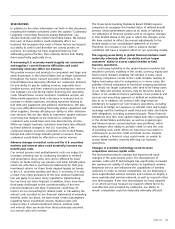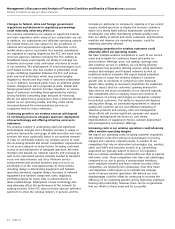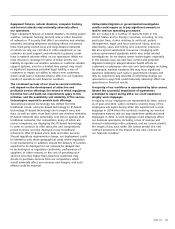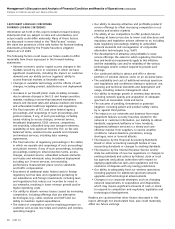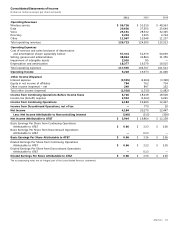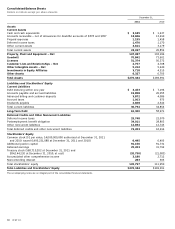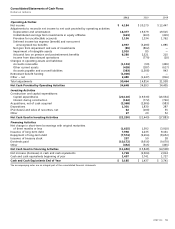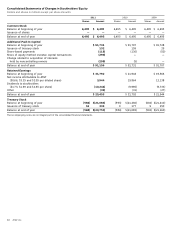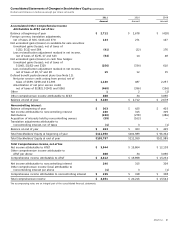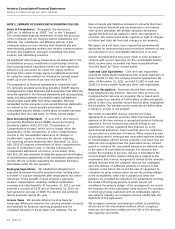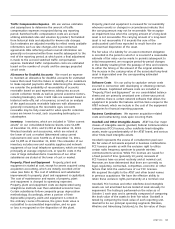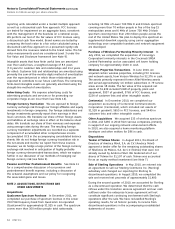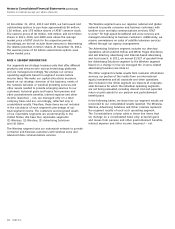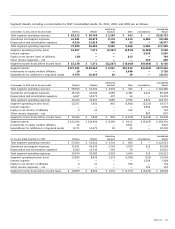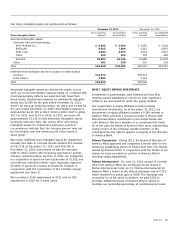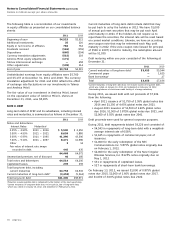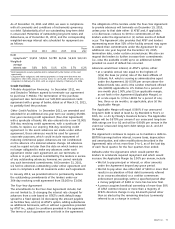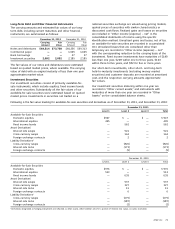AT&T Wireless 2011 Annual Report Download - page 65
Download and view the complete annual report
Please find page 65 of the 2011 AT&T Wireless annual report below. You can navigate through the pages in the report by either clicking on the pages listed below, or by using the keyword search tool below to find specific information within the annual report.
AT&T Inc. 63
Traffic Compensation Expense We use various estimates
and assumptions to determine the amount of traffic
compensation expenses recognized during any reporting
period. Switched traffic compensation costs are accrued
utilizing estimated rates and volumes by product, formulated
from historical data and adjusted for known rate changes.
Such estimates are adjusted monthly to reflect newly available
information, such as rate changes and new contractual
agreements. Bills reflecting actual incurred information are
generally not received within three months subsequent to the
end of the reporting period, at which point a final adjustment
is made to the accrued switched traffic compensation
expense. Dedicated traffic compensation costs are estimated
based on the number of circuits and the average projected
circuit costs.
Allowance for Doubtful Accounts We record an expense
to maintain an allowance for doubtful accounts for estimated
losses that result from the failure or inability of our customers
to make required payments. When determining the allowance,
we consider the probability of recoverability of accounts
receivable based on past experience, taking into account
current collection trends as well as general economic factors,
including bankruptcy rates. Credit risks are assessed based on
historical write-offs, net of recoveries, as well as an analysis
of the aged accounts receivable balances with allowances
generally increasing as the receivable ages. Accounts
receivable may be fully reserved for when specific collection
issues are known to exist, such as pending bankruptcy or
catastrophes.
Inventory Inventories, which are included in “Other current
assets” on our consolidated balance sheets, were $1,188
at December 31, 2011, and $1,303 at December 31, 2010.
Wireless handsets and accessories, which are valued at
the lower of cost or market (determined using current
replacement cost) were $1,082 as of December 31, 2011,
and $1,185 as of December 31, 2010. The remainder of our
inventory includes new and reusable supplies and network
equipment of our local telephone operations, which are stated
principally at average original cost, or specific costs in the
case of large individual items. Inventories of our other
subsidiaries are stated at the lower of cost or market.
Property, Plant and Equipment Property, plant and
equipment is stated at cost, except for assets acquired using
acquisition accounting, which are initially recorded at fair
value (see Note 2). The cost of additions and substantial
improvements to property, plant and equipment is capitalized.
The cost of maintenance and repairs of property, plant
and equipment is charged to operating expenses.
Property, plant and equipment costs are depreciated using
straight-line methods over their estimated economic lives.
Certain subsidiaries follow composite group depreciation
methodology. Accordingly, when a portion of their
depreciable property, plant and equipment is retired in
the ordinary course of business, the gross book value is
reclassified to accumulated depreciation, and no gain
or loss is recognized on the disposition of this plant.
Property, plant and equipment is reviewed for recoverability
whenever events or changes in circumstances indicate that
the carrying amount may not be recoverable. We recognize
an impairment loss when the carrying amount of a long-lived
asset is not recoverable. The carrying amount of a long-lived
asset is not recoverable if it exceeds the sum of the
undiscounted cash flows expected to result from the use
and eventual disposition of the asset.
The fair value of a liability for an asset retirement obligation
is recorded in the period in which it is incurred if a reasonable
estimate of fair value can be made. In periods subsequent to
initial measurement, we recognize period-to-period changes
in the liability resulting from the passage of time and revisions
to either the timing or the amount of the original estimate.
The increase in the carrying value of the associated long-lived
asset is depreciated over the corresponding estimated
economic life.
Software Costs It is our policy to capitalize certain costs
incurred in connection with developing or obtaining internal-
use software. Capitalized software costs are included in
“Property, Plant and Equipment” on our consolidated balance
sheets and are primarily amortized over a three-year period.
In addition, there is certain network software that allows the
equipment to provide the features and functions unique to the
AT&T network, which we include in the cost of the equipment
categories for financial reporting purposes.
Business Combinations We expense acquisition-related
costs and restructuring costs upon incurring them.
Goodwill and Other Intangible Assets AT&T has four major
classes of intangible assets: goodwill, Federal Communications
Commission (FCC) licenses, other indefinite-lived intangible
assets, made up predominately of the AT&T brand, and various
other finite-lived intangible assets.
Goodwill represents the excess of consideration paid over
the fair value of net assets acquired in business combinations.
FCC licenses provide us with the exclusive right to utilize
certain radio frequency spectrum to provide wireless
communications services. While FCC licenses are issued for
a fixed period of time (generally 10 years), renewals of
FCC licenses have occurred routinely and at nominal cost.
Moreover, we have determined that there are currently no
legal, regulatory, contractual, competitive, economic or other
factors that limit the useful lives of our FCC licenses.
We acquired the rights to the AT&T and other brand names
in previous acquisitions. We have the effective ability to
retain these exclusive rights permanently at a nominal cost.
Goodwill, FCC licenses and other indefinite-lived intangible
assets are not amortized but are tested at least annually for
impairment. The testing is performed on the value as of
October 1 each year, and is generally composed of comparing
the book value of the assets to their fair value. Goodwill is
tested by comparing the book value of each reporting unit,
deemed to be our principal operating segments (Wireless,
Wireline and Advertising Solutions), to the fair value of those


